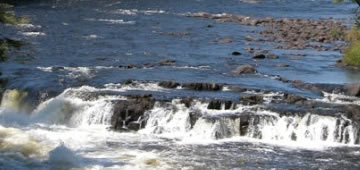River Facts and Resources
Wisconsin has more than 15,000 lakes and 84,000 miles of rivers and streams. Every year, watershed planning begins across the state with monitoring to evaluate the health of Wisconsin's waters. Biologists and trained volunteers collect monitoring data on representative segments on rivers, streams and lakes across the state. Water quality data are evaluated against water quality standards to assess the condition, or health, of our waters. Department staff conduct research to better define the pollutants, pollutant sources and impairments and develop plans that identify management activities and strategies to enhance and protect our waters.
River Facts
About Wisconsin Rivers
Wisconsin has more than 12,600 rivers and streams that meander their way through 84,000 miles of varying terrain. About 32,000 miles of these streams run continuously throughout the year; the remainder flow intermittently during spring and other high water times.
- There are nearly 2,700 trout streams in Wisconsin; put end to end, they would stretch more than 10,370 miles.
- The Mississippi River winds its way through about 200 miles of Wisconsin and drains the third largest area of land in the world. With its 250 tributaries and branches, the river drains 41 percent of the country’s water from all or part of 31 states.
- More than 100 varieties of warm water fish are found in the Upper Mississippi.
- Wisconsin Rivers and streams host about 4,700 dams of varying sizes, more than half of them owned by private individuals. The state owns 19 percent, and townships and county governments own 16 percent.
- More than 50 percent of Wisconsin dams were built for recreational purposes, 13 percent to generate power, and 10 percent for fire control reasons or to create farm ponds.
- Wisconsin has one of the longest free-flowing stretches of river, the Baraboo River, in the nation. The removal of four dams in the 1990s has allowed canoeists and other boaters to enjoy a 112–mile free-flowing stretch of this river.
- Wisconsin has nearly 1,600 stream and river miles designated as "outstanding" and recognized as the state’s highest quality water resources.
- Kayakers and other whitewater enthusiasts will find 503 miles of whitewater rivers to challenge them.
Initiatives
River Initiatives
- Waterways Permits
- Dams Grants [exit DNR]
- Water Action Volunteers [exit DNR]
- Lower Wisconsin Riverway
River Planning
River planning teams are working throughout Wisconsin to identify high priorities for monitoring, management and protection of the state’s rivers and streams. The DNR and partner groups regularly update water quality management plans that outline land and water conditions in river and lake basins statewide. These plans are designed to identify resource protection measures to ensure the healthy long–term management of Wisconsin's Rivers and streams. The data for these plans are updated on an ongoing basis.
Protection
River Protection
Protecting water resources involves incentives (grants, cost-share agreements, education), regulation (standards, permits, enforcement) and purchases or easements. Below are links to a broad range of activities, tools and organizations that collectively help protect our rivers.
Incentives and Education
- Urban Rivers Stewardship Grants
- Surface Water Grants
- Citizen Lake Monitoring Network
- Water Action Volunteers
- Areawide Water Quality Management Planning
- Angler and Aquatic Education
Regulation
- Water Quality Standards and Classifications
- Surface Water Impairments and Pollutants
- TMDLs
- Wastewater Permits
- Waterway & Wetland Permits
- Floodplain Management and Mapping

